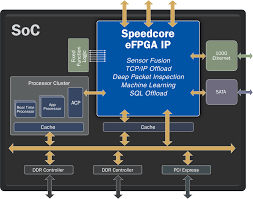Embedded Field-Programmable Gate Arrays (eFPGAs) in Full-Stack Innovation
Embedded Field-Programmable Gate Arrays (eFPGAs) are redefining the semiconductor landscape by blending the post-fabrication flexibility of traditional FPGAs with the performance and efficiency of application-specific integrated circuits (ASICs). This integration provides a powerful solution for industries seeking adaptable, future-ready technologies. As full-stack development increasingly spans hardware, software, data, and cloud infrastructure, eFPGAs are enabling intelligent, real-time computing at the edge and beyond.
eFPGA Technology Overview
An eFPGA is a reconfigurable IP block embedded within ASICs or Systems-on-Chips (SoCs). Unlike standalone FPGAs, eFPGAs reduce system complexity, board space, and power consumption while maintaining the flexibility to update logic functions post-manufacturing.
Key Benefits:
- Security: Algorithms can be securely programmed after fabrication, reducing IP theft risks.
- Adaptability: Easily adjust to changing protocols such as 5G, automotive standards, and industrial connectivity.
- Performance: Tight ASIC integration delivers lower latency and superior energy efficiency.
eFPGA in Full-Stack Applications
1. Hardware Layer
eFPGAs enable real-time hardware adaptability by embedding programmable logic directly into chips, suitable for dynamic workloads:
- 5G Infrastructure: Socionext’s 7nm ASIC with embedded FPGA provides dynamic protocol support, eliminating costly hardware redesigns.
- Edge AI Devices: Menta’s eFPGA IP accelerates neural networks for energy-constrained IoT applications.
- Automotive Systems: In-vehicle communication modules use eFPGAs to adapt to V2X security and data protocols.
- Financial Trading Hardware: Ultra-low latency systems use eFPGAs to accelerate market data processing.
2. Software Layer
eFPGAs interact with system software to offload compute-intensive tasks and support runtime reconfiguration:
- Custom Accelerators: Enhance CPUs/GPUs by offloading encryption, compression, and AI inference workloads.
- Runtime Bitstream Updates: Tools like Flex Logix’s software platforms enable remote, secure updates.
- Embedded Linux Integration: Lightweight OS support enables seamless coordination with eFPGA logic for dynamic applications.
3. Data & Analytics Layer
In the era of edge and industrial AI, eFPGAs allow for immediate data filtering and preprocessing:
- Industrial IoT (IIoT): Perform in-sensor data compression and anomaly detection before cloud upload.
- Predictive Maintenance: Analyze vibration, temperature, or pressure data in real time to reduce equipment failure.
- Smart City Applications: Use reconfigurable logic to process dynamic sensor data (e.g., traffic, pollution, lighting).
4. Deployment & Scaling
Cloud-native DevOps principles are now extending to hardware via eFPGA:
- CI/CD for Bitstreams: Treat hardware configurations as code using containers and automation pipelines.
- Edge Device Deployment: Use Docker/Kubernetes to manage eFPGA-configured nodes across geographies.
- Security Management: Employ signed bitstreams and zero-trust policies to protect firmware and logic updates.
IAS-Research.com’s Role in eFPGA-Driven Transformation
IAS-Research.com supports organizations in designing, implementing, and scaling eFPGA-powered systems. Their expertise spans VLSI, AI/ML, IIoT, and system-level engineering, enabling end-to-end innovation.
1. System Design & Integration
- Digital Twin Simulation: Use tools like Unity ML-Agents and AnyLogic to simulate ASIC-eFPGA behavior before silicon tape-out.
- Hardware/Software Co-Design: Partition compute tasks between CPUs, eFPGAs, and accelerators for optimal efficiency.
- Embedded Linux & RTOS Support: Tailor system software to communicate with eFPGA hardware interfaces.
2. AI/ML Optimization
- Reinforcement Learning for Reconfiguration: Train agents to dynamically reconfigure eFPGA logic for real-time workloads.
- ML Model Compression & Deployment: Convert PyTorch/TensorFlow models into hardware-friendly bitstreams.
- AutoML Pipelines: Create automated workflows to map ML algorithms onto eFPGAs for scalable inference.
3. Full-Stack IIoT Development
- Edge AI Gateways: Implement eFPGA-enabled preprocessing for real-time decision-making at the edge.
- Cloud-to-Edge Synchronization: Enable bidirectional updates between cloud analytics and local eFPGA configurations.
- Industrial Interoperability: Align with OPC-UA, Modbus, and custom protocols through programmable logic blocks.
4. Security & Compliance
- Post-Fabrication Programming: Secure deployment of IP after tape-out to reduce cloning and reverse engineering risks.
- Secure Enclave Implementation: Use eFPGAs to host cryptographic or AI functions in isolated logic zones.
- Compliance Support: Assist in aligning eFPGA deployments with defense, healthcare, and automotive standards (e.g., ISO 26262, HIPAA).
Cross-Industry Use Cases Enabled by IAS-Research.com
Telecom
- Adaptive 5G Base Stations: Real-time beamforming and protocol reconfiguration via embedded FPGA logic.
- Outcome: 40% power reduction, 6-month faster deployment.
Industrial IoT
- Predictive Maintenance: Edge processing for vibration and fault analytics reduces downtime and bandwidth.
- Outcome: 30% fewer maintenance incidents, real-time asset health tracking.
Defense and Aerospace
- Secure FPGA Programming: Post-manufacture logic encryption using eFPGA reduces IP leakage.
- Outcome: Hardened systems with mission-critical adaptability.
Automotive
- Dynamic ECU Firmware: Car-to-car communication protocols updated via secure bitstream delivery.
- Outcome: Future-proof vehicle communications and reduced recall risk.
MedTech
- Wearable Health Devices: Lightweight eFPGAs preprocess biosignals for real-time alerts.
- Outcome: Lower latency, extended battery life, better patient monitoring.
Conclusion
eFPGAs are driving a new era in full-stack engineering—offering the speed of ASICs with the adaptability of FPGAs. Their applications span real-time analytics, dynamic reconfiguration, and secure computation. IAS-Research.com plays a strategic role by providing full-lifecycle support, from digital twin simulations to edge AI pipelines, enabling organizations to adopt eFPGA technology confidently and effectively.
References:
- https://media.defense.gov/2023/Oct/26/2003328220/-1/-1/0/CTR-Commercial-eFPGA-Evaluation-Report-v1.1.PDF
- https://circuitcellar.com/insights/the-future-of-embedded-fpgas-efpga-the-proof-is-in-the-tape-out/
- https://www.ias-research.com
- https://www.keencomputer.com/solutions/software-engineering/673-ai-agents-in-action-practical-applications-and-strategic-enablement-with-ias-research-com-and-keencomputer-com
- https://semiengineering.com/knowledge_centers/integrated-circuit/ic-types/fpga/embedded-fpga-efpga/
- https://www.electronicdesign.com/technologies/embedded/article/55088374/menta-build-edge-ai-systems-using-efpga-technology
- https://www.achronix.com/blog/back-basics-laymans-introduction-efpga
- https://www.utmel.com/blog/categories/integrated%20circuit/what-is-efpga



